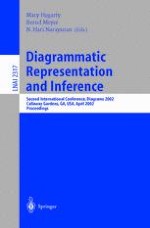2002 | OriginalPaper | Buchkapitel
Compositional Semantics for Diagrams Using Constrained Objects
verfasst von : Bharat Jayaraman, Pallavi Tambay
Erschienen in: Diagrammatic Representation and Inference
Verlag: Springer Berlin Heidelberg
Enthalten in: Professional Book Archive
Aktivieren Sie unsere intelligente Suche, um passende Fachinhalte oder Patente zu finden.
Wählen Sie Textabschnitte aus um mit Künstlicher Intelligenz passenden Patente zu finden. powered by
Markieren Sie Textabschnitte, um KI-gestützt weitere passende Inhalte zu finden. powered by
We present a novel approach to the compositional semantics for a large family of diagrams. Examples include engineering drawings such as circuit diagrams, trusses, etc., process control diagrams such as traditional program flowcharts, data-flow diagrams depicting traffic flow or the dependency relationships between operators, etc. Providing a compositional semantics involves defining the meaning of the whole diagram in terms of the meanings of its parts. A common characteristic of these diagrams is that we need to depict both structure and behavior of some artifact, procedure, function, etc. We view these diagrams as graphs that are made up of nodes and edges. The meaning of each diagrammatic element (e.g., node) as well as the connections between elements (e.g., edge) are given in terms of a constrained object [3]. A constrained object is an object whose attributes may be subject to one or more constraints, i.e., relations among the attributes. While the concept of an object and its attributes captures the structural aspects of a diagrammatic element, the concept of constraint captures its behavioral properties. Constrained objects may be thought of as declarative counterparts of the traditional objects found in object-oriented languages.
